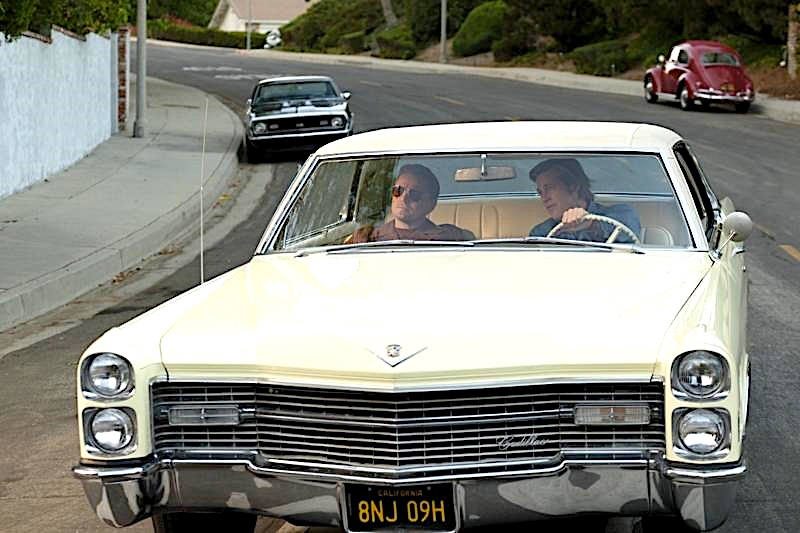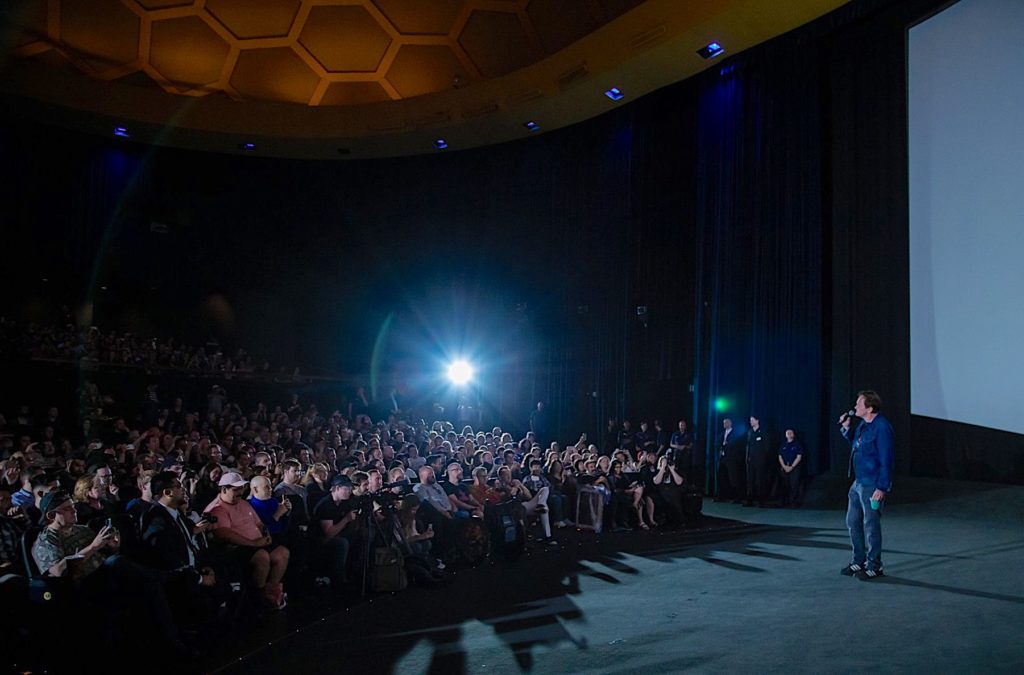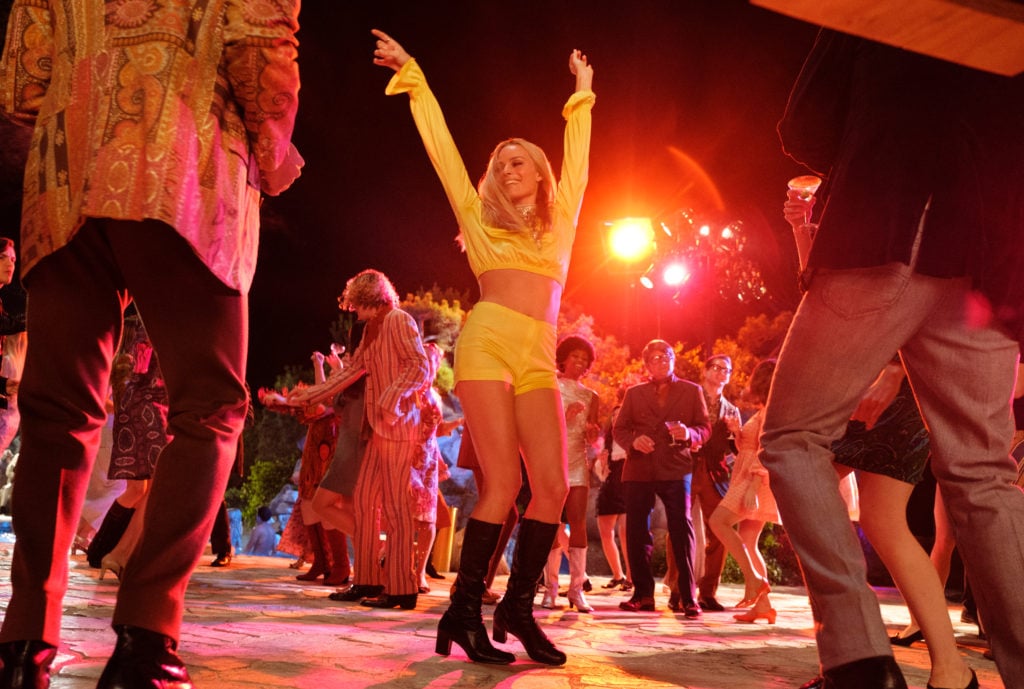Watching Quentin Tarantino’s highly anticipated ninth film, Once Upon A Time in Hollywood this past weekend at the Cinerama Dome was a surreal experience, and not just because the filmmaker was there to excitedly and, as he admitted, tipsily introduce the film and watch it with us. The historic theater and Sunset Boulevard (circa 1969), get some screen time in the movie, which incited cheers from the audience we saw it with, as does Hollywood Boulevard with the venerable Musso & Frank, Pussycat porn theater and Grauman’s Chinese Theatre (where the official premiere took place this week) all gregariously aglow with nary an LCD in sight.
You don’t have to live in L.A. to dig the nostalgic immersion of this latest creation by the writer/director who no one would dispute is one of cinema’s greatest visionaries, but you probably do have to love this city on some level. I won’t say it’s a love letter to Hollywood/old Hollywood or even the ’60s, though some will surely use that old cliche. That’s much too trite for Tarantino, though. He doesn’t idealize his subjects or his settings so much as devour them and let us devour them with him, often fetishizing (their beauty, their brutality, their sensitivity, their style) then testing them, and at well-timed turns, tearing them open and bringing us along for the ride. And what a ride it is.

Leonardo DiCaprio and Brad Pitt in Once Upon A Time in Hollywood (Columbia Pictures)
Expect plenty of rides in fact. Literally. Tarantino films his actors behind and in front of the wheel a lot, and it not only makes sense in terms of depicting our car-dependent culture (even in the ‘60s), it draws us into their physical space and unique point of view as they roll through the city and past the glamorous guises — neon, sunsets, flashy cars, even traffic — of the past. Visually stunning, even when it’s intentionally grainy and chaotic, the film was shot by Academy-award winning cinematographer Robert Richardson, whom Tarantino worked with on both Kill Bills, Inglourious Basterds, Django Unchained and Hateful Eight.
It’s got to be said, though: even with narration by Kurt Russell (who plays a stunt coordinator) and Pitt attempting to give it a little structure, this film has virtually no real plot. That’s a bit of a disappointment because the much-touted Manson family story-line could’ve been so compelling in Tarantino’s hands. The Helter Skelter stuff isn’t even really a subplot, but rather a backdrop, as the film is sort of a countdown to the tragic night that Sharon Tate and her friends were murdered by Charlie’s followers in her home in the hills of L.A. Things turn out a little differently in Quentin’s version, but at the request of the director — who has been asking journalists not to spoil the twist and reiterated this plea to us at the Dome — I won’t elaborate, except to say that there’s a pretty satisfying and Tarantino-esque climax.

Quentin Tarantino introduces One Upon A Time In Hollywood — in Hollywood, concluding the Arclight’s Tarantino Screening Series last weekend at the Cinerama Dome. (Courtesy Arclight Hollywood)
Even without a proper narrative, this star-powered vehicle works. In case the title didn’t make it clear, Hollywood is both the subject and the star here, and she’s everything we might want from a leading lady — gorgeous, complex, familiar yet surprising at times, decadent, dangerous, almost too divine to be a real… She even outshines her co-stars- Leonardo DiCaprio and Brad Pitt, who turn in a couple of the most beguiling performances of their careers. Much has been made of Margot Robbie’s comparatively simplistic and scant role and indeed, her acting gifts are way underused, but her channeling of Tate is pivotal to the picture Tarantino wants to paint, wherein the entertainment industry’s evolution begins to usher in a colorful new wave, with bikers, hippies and models suddenly seeming a lot more interesting and sexy than cowboys, soldiers and housewives. The rising star’s murder near the end of her pregnancy and its peace and love era-ending eeriness notwithstanding, the real Tate’s role (and that of Patty Duke’s Neely O’Hara) in Valley of the Dolls is obvious subtext here, especially for the trajectory of DiCaprio’s TV actor Rick Dalton who battles alcoholism while trying to stay relevant as an actor and ends up making B-movies in Italy.
Pitt plays Cliff Booth, Dalton’s buddy, personal assistant and former stunt double from back when he starred on the popular ’50s TV western Bounty Law. Dalton’s struggle to transition since his show ended means taking meetings with smarmy showbiz types (Al Pacino) at Musso, and prepping for smaller roles as “the heavy” in still-surviving, slightly corny episodic television fare. In addition to the pastiche of flashback sequences, commercials and trailers showcasing Dalton’s acting work throughout Once Upon A Time, we also get a story-within-the-story, with some really fun but hefty acting by Dalton/Dicaprio as a villain in the TV show Lancer, playing opposite Timothy Olyphant and Luke Perry as the title character (a bittersweet meta-casting if there ever was one; from TV star to movie star in his last role).

Margot Robbie as Sharon Tate, dancing at the Playboy Mansion, in Once Upon A Time In Hollywood.
The studio back lot scenes are the best. They may not be as visually intriguing as those shot on the road, at the Playboy Mansion, inside the character’s fancy/filthy homes or inside Spahn Ranch (which I found underwhelming), but dramatically, they yield the film’s most profound pleasures, providing behind the scenes glimpses into set life and production, from the lofty, last-minute decisions made inside makeup trailers to heady conversations about “the craft” (here, had with a precocious 8-year-old) to the downtime, when stars are just hanging out, shooting the shit and showing off (the scene in which Bruce Lee gets his ass kicked is cringy and pure comic gold).
Though it runs at 2 hours and 40 minutes, Once Upon A Time rarely drags because there is always something to look at, notice and absorb. This attention to detail is something Tarantino has honed over the years, and it’s evident in the period styling (flawless work by costume designer Arriane Phillips) and of course, in the music, which is heard via car radios (cut with commercials from then-popular local radio station KHJ), on home turntables and as the filmmaker does so well, as a seamless storytelling device that functions as a cool time capsule-like score too. Tarantino is always heavily involved in the music of his films and he shamelessly plays his Scorsese card near the end of this one, tying things up with a melodious bow, only to brilliantly tear it open before credits roll. During a flash-forward sequence and airport montage, The Rolling Stones’ “Out of Time” not only foreshadows this fierce fairy tale’s ending (though not in the way history might lead you to believe), it also evokes his characters, the film and Hollywood’s transition into a dark, less idealistic new era.
Advertising disclosure: We may receive compensation for some of the links in our stories. Thank you for supporting LA Weekly and our advertisers.

